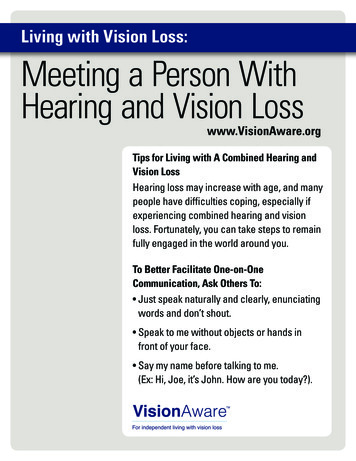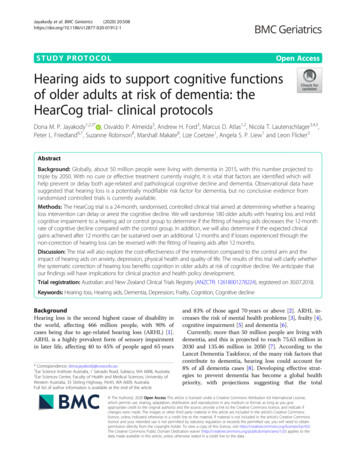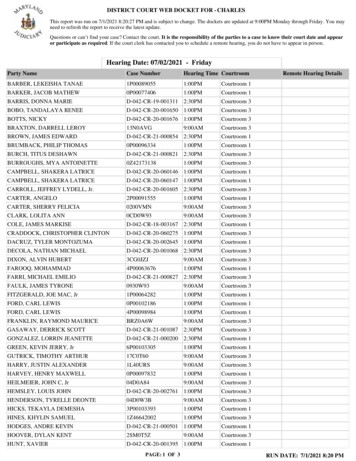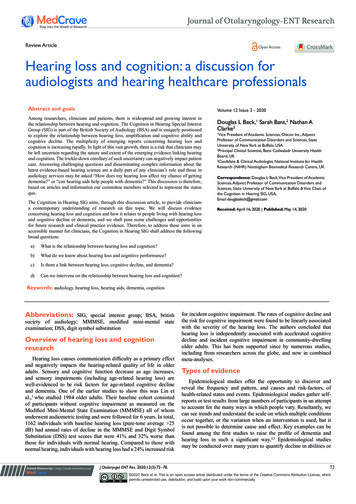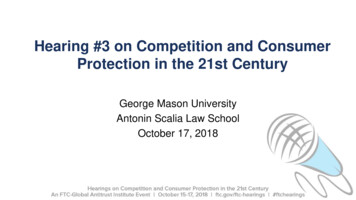
Transcription
Hearing #3 on Competition and ConsumerProtection in the 21st CenturyGeorge Mason UniversityAntonin Scalia Law SchoolOctober 17, 2018
WelcomeDerek W. MooreFederal Trade CommissionOffice of Policy Planning
Understanding Exclusionary Conduct inCases Involving Multi-Sided Platforms:Predatory Pricing, Vertical Restraints, andMFNsSession moderated by:Ian R. ConnerFederal Trade CommissionBureau of Competition
Understanding Exclusionary Conduct inCases Involving Multi-Sided Platforms:Predatory Pricing, Vertical Restraints, andMFNsRichard L. SchmalenseeMassachusetts Institute of TechnologySloan School of Management
Understanding Exclusionary Conduct inCases Involving Multi-Sided Platforms:Predatory Pricing, Vertical Restraints, andMFNsThomas P. BrownPaul Hastings LLP
Understanding Exclusionary Conduct inCases Involving Multi-Sided Platforms:Predatory Pricing, Vertical Restraints, andMFNsSusan AtheyStanford UniversityGraduate School of Business
Understanding Exclusionary Conduct inCases Involving Multi-Sided Platforms:Predatory Pricing, Vertical Restraints, andMFNsJudith A. ChevalierYale UniversitySchool of Management
Understanding Exclusionary Conduct inCases Involving Multi-Sided Platforms:Predatory Pricing, Vertical Restraints, andMFNsPinar AkmanUniversity of LeedsSchool of Law
MFNs on multi-sided markets are closer to Price-MatchingGuarantees.Regular MFNPlatform MFNSellerSellerMFNMFNPlatform 1p1Platform 2p2Customer 1Customer 2p1 p2Links prices betweendifferent customers ofthe same seller.p1p2Customer 1p1 p2Links prices for the samecustomer buying fromdifferent (competing)outlets.
Understanding Exclusionary Conduct inCases Involving Multi-Sided Platforms:Predatory Pricing, Vertical Restraints, andMFNsPanel DiscussionPinar Akman, Susan Athey,Thomas P. Brown, Judith A. Chevalier,Richard L. SchmalenseeModerator: Ian R. Conner
Break10:45-10:55 am
Understanding Exclusionary Conduct in CasesInvolving Multi-Sided Platforms: Issues Relatedto Vertically Integrated PlatformsBarbara BlankFederal Trade CommissionBureau of Competition
Understanding Exclusionary Conduct in CasesInvolving Multi-Sided Platforms: Issues Relatedto Vertically Integrated PlatformsAmy RayOrrick, Herrington & Sutcliffe LLP
Understanding Exclusionary Conduct in CasesInvolving Multi-Sided Platforms: Issues Relatedto Vertically Integrated PlatformsHal SingerEcon One Research
Vertical Integration and Exclusivity inPlatform & Multi-Sided MarketsRobin S. LeeHarvard UniversityDepartment of Economics
Welfare Effects of VI in Multichannel TVRSNARSNB Efficiencies: Dbl Marginalization, Alignment of Investment Incentives Foreclosure: Downstream (exclusion, RRC), Upstream (Non-Carriage)CableSat Simulates Divestitures/Mergers of 30 RSNs (2007)Consumers When exclusion occurs, total/consumer welfare harmed Even so, predicted efficiencies outweigh foreclosure effectson average across channelsG. Crawford, R. S. Lee, M. D. Whinston, A. Yurukoglu, “The Welfare Effects of Vertical Integration in MultichannelTelevision Markets,” Econometrica, May 2018. http://dx.doi.org/10.3982/ECTA14031
VI/Exclusivity in Dynamic HW/SW MarketsTitleAMSFTTitleBSony Finding: Exclusivity assisted “Entrant” HWplatforms, fostering platform competition Entrants needed to outbid/out-develop incumbent to obtaincompetitive advantage (May have had adverse effects on upstream competition) Additional Considerations:Consumers Consumer “multi-homing” Strength of Network EffectsR. S. Lee, “Vertical Integration and Exclusivity in Platform and Two-Sided Markets,” American Economic Review,December 2013. http://dx.doi.org/10.1257/aer.103.7.2960
Understanding Exclusionary Conduct in CasesInvolving Multi-Sided Platforms: Issues Relatedto Vertically Integrated PlatformsLesley ChiouOccidental CollegeDepartment of Economics
Understanding Exclusionary Conduct in CasesInvolving Multi-Sided Platforms: Issues Relatedto Vertically Integrated PlatformsNicolas PetitUniversity of Liège School of Law
Understanding Exclusionary Conduct in CasesInvolving Multi-Sided Platforms: Issues Relatedto Vertically Integrated PlatformsSusan CreightonWilson Sonsini Goodrich & Rosati
Understanding Exclusionary Conduct in CasesInvolving Multi-Sided Platforms: Issues Relatedto Vertically Integrated PlatformsPanel DiscussionLesley Chiou, Susan Creighton,Robin Lee, Nicolas Petit,Amy Ray, Hal SingerModerator: Barbara Blank
Lunch Break12:45-1:30 pm
Nascent CompetitionBilal SayyedFederal Trade CommissionOffice of Policy Planning
Nascent Competition:Platforms and Market StructureSusan AtheyStanford UniversityGraduate School of Business
Questions and Concepts Do platforms tendtowards monopoly? When are platformsprofitable? Is it possible to enter andsucceed againstestablished incumbents? Platform economics Economies of scale Market structure & ProfitabilityoooGetting startedScaling and growthHorizontal v. vertical expansion Entry: the startup v. theincumbent Regulation and impact onsociety
American Airlines Defends Computer SystemBy Douglas B. FeaverJune 3, 1982 the Justice Department was one month into a preliminaryantitrust investigation to determine if "computerizedscheduling and reservation services might have beenmanipulated" as to give a crucial advantage to the systemoperators, a Justice spokesman said.
American Airlines Defends Computer SystemBy Douglas B. FeaverJune 3, 1982 Crandall said that the best guarantee that the Sabre system does not unfairly favorAmerican Airlines is the fact that travel agents buy the system, "so it must accuratelyrepresent what is available" on all airlines.However, American builds what Crandall calls a "bias" into the computer program. Forexample, he said, if a potential customer wants to go to Chicago at 9 a.m., the travelagent asks Sabre for the flights. The first list on the terminal will include the bestservice, regardless of airline, but if American has a flight within 30 minutes of thedesired time, and another airline is closer, American's flight is listed first.American, he said, had invested 110 million in Sabre and spends 25 millionannually to run it. It was built, he said, "with our dollars, at great risk."
Issues in Sabre Case Manipulation softened price competition and misled consumers,but was not sufficient to induce travel agents to switch systems. Manipulation probably led to exit of some low-cost airlines bymaking it less profitable to enter and compete againstAmerican. Counterfactual: Airlines must compete on price; low-cost airlineis able to get a toe-hold and grow into a competitor. Vertical integration helped American airlines maintain profits.
Platforms, the supply side, and welfare Supermarkets sell generics at lower prices than branded products. Walmart ensures suppliers are competitive, low-margin. AirBnb ranks more highly hosts who respond quickly, maintaincalendar availability. eBay rewards sellers with good feedback and who ship quickly. Price comparison engines facilitate consumer search, penalizeobfuscation. Search engines demote irrelevant ads. Integration of security software into OS.
Threats to a Dominant Platform A more focused platform rival solves chicken and egg problem in anarrow category, steals share, and expands breadth. A service provider becomes so relevant to consumers that theyconnect directly with the provider and grows from there. Amazon & Google search YouTube & search Another intermediary aggregates a large set of consumers, can movethem to another platform, shifting scale dynamics. Large intermediary can extract rents Google search & mobile OS, browser, etc.
Platforms and DisintermediationReferring ServiceDependent ServicePC OSApp StoreBrowser, Media Player, SearchEngine, AppsBrowser, Entertainment, SearchEngine, Mapping, Key AppsAppsBrowserSearch Engine, Other ServicesSearch EngineVertical search, websitesMobile CarrierMobile platform, pre-installedservices/apps, search defaultsSocial NetworkInternet news media, social appsAd ExchangePublisher ad selling tools,Advertiser ad buying toolsMobile OSExamples Windows IE v. ChromeApple SafariAndroid Search, MapsAll Amazon shop, Kindle Chrome Google Search Google Shopping, Maps,Finance AT&T Apple v. Android;Navigation Services; TV Facebook News, Zynga Google Ad Exchange Google Ad Manager
Platform Responses to ExistentialThreat from Vertical ServiceWELFARE-ENHANCING RESPONSES Create a superior vertical serviceto compete with threat Create a better platform toensure that: Consumers don’t bypass platform Vertical service can’t grow into fullfledged platform competitorWELFARE-HARMING RESPONSES Make or buy an adequatevertical service Promote/advantage it to take awaycustomers from competing verticalservices When is this particularly harmful? Innovative services Scale-driven services Services with network effects
Platforms get in between afirm and its consumers Consumers are verysensitive to the rankingand prominence of results13.5%CTRDependenceon PlatformsPlatform dependence illustrated by theloss in CTR from page position demotion17.9%21.6%25.4%4.9%Randomized experiment atBing shows firms lose halftheir traffic when demotedfrom first to third positionin algorithmic search3.5%6.9%Control(1st Position)(1,3)4.0%1.7%2.1%(1,5)(1,10)Loss from DemotionGain from Increased RelevanceOriginal CTR of Position
Vertical Manipulation in Ad TechGoogle Removes Its 'Last-Look'Auction Advantageby Sarah Sluis / Friday, March 31st, 2017 – 12:34 pm Previously, AdX would wait for all those other exchanges to submittheir bids, and then give itself a chance to outbid the winner. So ifGoogle’s exchange had two bids of 1 and 5, it would be able tobeat a 4 bid from an outside exchange. Under the new auctionrules, it would submit a bid of 1 (the second price) and lose theauction.And Google will retain one additional advantage in the auction: Itknows more about the user than it passes on to the other exchanges.
Example Threats by Platform TypeE-CommerceRidesharingOS If consumers needto compare onsearch engines,ecommerce firmsmust yield most ofprofit back tosearch engines Competitor ridesthe coattails offirst mover’ssupply acquisition,takes advantageof user andsupplier multihoming New hardwareformat breaksconsumer habits With sufficientcompetition,strong incentive toprovide valueproposition Incumbentadvantages incustomeracquisition Niche generalplayer solveschicken & egg,grows Consumersaccess servicesdirectly, don’t careabout OSSearch EngineSocial Network OS, device, servicesends searches tocompeting provider Consumers loseinterest Combination of verticalshave consumers bypasssearch Alternative socialnetwork becomespopular Vertical competitorgrows into horizontalone General competitorgrows advertiser basesufficiently to competefor business deals General competitor getsenough scale to makehigh enough qualityservice to threatenconsumer base Less threat fromadvertising side
Profitability, Success, & Market Structure How important are cross-side networkeffects? Easiest to grow/enter new market in avertical Horizontal vulnerable to competition fromvertical players Expand horizontally on buy side How differentiated are buyer needs/sellerproducts in space, time, and product? Is there room for platformdifferentiation on either or both sides? Network effects within niches Multi-home on one or both sides ofmarket Switching costs How important is crowding?Other sources of scale economies ML in search & matching Other R&DVertical v. Horizontal Will the platform get cut out? Can someone aggregate buy or sell side,or can a single buyer or seller growenough, to take their customers/suppliersand leave? Do buyers and sellers developrelationship with one another, notplatform? Is the reputationalinformation/matchmaking provided byplatform valuable? Is matching hard and time-sensitive? Do sellers need platform’s business, andthus respond to incentives to transact onplatform?
Nascent and Potential Competition:The Current Analytical FrameworkPaul T. DenisDechert LLP
Overview Definitional issues Nascent and potential competition concepts pervade theframework for U.S. antitrust merger analysis Filling out the framework
Definitional Issues Nascent competition No formal legal definition Suggests that competition is felt presently, but not yet fully realized; acquisition ofnascent competitor extinguishes both current competition and the prospect for greatercompetition in the future Potential competition Bifurcated concept as articulated by the courts Perceived potential competition – present competitive effect based on prospect of futureentry; acquisition of potential entrant leads to reduction in current competition Actual potential competition – future competitive effect that likely would be felt fromfuture entry; acquisition of potential entrants prevents increase in competition thatotherwise would result
Nascent and Potential CompetitionConcepts Pervade Merger Analysis Determining the benchmark price in market definition/measurementIdentification of market participantsAssignment of market sharesMeasurement of market concentrationDefining the competitive effect of concernAlternatives to traditional product market definitionEntryBut asymmetric treatment persists – nascent and potential competition morereadily recognized as a force to be protected than a force that protectsagainst noncompetitive performance
Determining the Benchmark Price “If prices are likely to change absent the merger, e.g.,because of innovation or entry, the Agencies may useanticipated future prices as the benchmark for the test.”Horizontal Merger Guidelines (2010), Section 4.1.2
Identification of Market Participants New entrants – “Firms not currently earning revenues in the relevant market, but that havecommitted to entering the market in the near future, are also considered marketparticipants.” Rapid entrants (a.k.a. uncommitted entrants) – “Firms that are not current producers in arelevant market, but that would very likely provide rapid supply responses with directcompetitive impact in the event of a SSNIP, without incurring significant sunk costs, are alsoconsidered market participants.”Horizontal Merger Guidelines (2010), Section 5.1
Assignment of Market Shares Incumbent shares may be adjusted based on market change – “The Agenciesconsider reasonably predictable effects of recent or ongoing changes in marketconditions when calculating and interpreting market share data.” Shares of other market participants assigned based on future competitivesignificance – “The Agencies . . . calculate market shares for [firms that do notcurrently produce products in the relevant market] . . . if this can be done to reliablyreflect their competitive significance.”Horizontal Merger Guidelines (2010), Section 5.2
Measurement of Market Concentration Use of projected shares – “In analyzing mergers between an incumbent and arecent or potential entrant, to the extent the Agencies use the change inconcentration to evaluate competitive effects, they will do so using projected marketshares.” “A merger between an incumbent and a potential entrant can raise significantcompetitive concerns. The lessening of competition resulting from such a merger ismore likely to be substantial, the larger is the market share of the incumbent, thegreater is the competitive significance of the potential entrant, and the greater is thecompetitive threat posed by this potential entrant relative to others.”Horizontal Merger Guidelines (2010), Section 5.3
Defining the Competitive Effect of Concern Horizontal Potential competition Vertical
Competitive Effect of Concern - Horizontal Price effects Output effects - “enhanced market power also can be manifested in . . . reducedproduct quality, reduced product variety, reduced service or diminished innovation.” Innovation effects - a merger that “is likely to encourage one or more firms to . . .diminish innovation” is said to enhance market powerHorizontal Merger Guidelines (2010), Sections 1, 2.2.1
Competitive Effect of Concern – Horizontal –Innovation Effects Reduced incentive to continue with an existing product-development effort Reduced incentive to initiate development of new products Efficiencies analysis also considers “whether the merger is likely to enable innovation thatwould not otherwise take place, by bringing together complementary capabilities that cannotbe otherwise combined or for some other merger-specific reason.”Horizontal Merger Guidelines (2010), Section 6.4 But there is yet no generalized theory of the link betweeninnovation and either mergers or market structure more generally
Competitive Effect of ConcernPotential Competition Doctrine Perceived potential competition – present competitive effect basedon prospect of future entry Accepted by the Supreme Court in United States v. MarineBancorporation, 418 U.S. 602 (1974) Actual potential competition – future competitive effect that likelywould be felt from future entry Supreme Court has twice reserved on whether this states a claim inUnited States v. Marine Bancorporation, 418 U.S. 602 (1974) and UnitedStates v. Falstaff Brewing Corp., 410 U.S. 526 (1973)
Competitive Effect of Concern –Perceived Potential Competition Doctrine Market structure – concentration or other structural evidence that entry likely wouldhave procompetitive effect Uniqueness - acquired company is one of few comparable potential entrants Effect - perception of entry altered incumbent behavior
Competitive Effect of Concern –Actual Potential Competition Doctrine Market structure – concentration and other structural evidence that entry likelywould have procompetitive effect Uniqueness -acquired company is one of few comparable potential entrants Plan - subjective intent to enter/objective evidence of capacity to enter Likelihood - substantial likelihood of procompetitive effect from entry Elevated standard of proof – See, e.g., In re BAT Industries, 104 F.T.C. 852, 926-28(1984) (“clear proof”)
Alternatives to Traditional Product MarketDefinition Innovation markets Technology markets R&D markets
Filling Out the Framework Empirical foundation - limited empirically grounded economic analysis of the effectsof nascent competition or its elimination Retrospective analysis – need for retrospective analysis of predictive tools Probability - no generally accepted threshold of what probability of successwarrants consideration of nascent competition Temporal dimension Absence of clear guidance on threshold applied by the agencies How far out in time can we credibly project the success of nascent competitors?
Temporal Dimension of Effect fromNascent or Potential CompetitionCategory2010 Guidelines1992 GuidelinesMarketParticipants“Committed to entering” in the “near future” or“rapid supply responses”Supply responses likely to occur“within one year;” SSNIPassumed to last one yearEntryTimely is “rapid enough to make unprofitableoverall the actions causing [the competitiveeffect of concern]”Timely is “two years from initialplanning to significant marketimpact”
Nascent Competition: Is the CurrentAnalytical Framework Sufficient?Session moderated by:Bilal SayyedFederal Trade CommissionOffice of Policy Planning
Nascent Competition: Is the CurrentAnalytical Framework Sufficient?Lina M. KhanColumbia University Law School
Nascent Competition: Is the CurrentAnalytical Framework Sufficient?John M. NewmanUniversity of MemphisCecil C. Humphreys School of Law
Nascent Competition: Is the CurrentAnalytical Framework Sufficient?William P. RogersonNorthwestern UniversityDepartment of Economics
Nascent Competition: Is the CurrentAnalytical Framework Sufficient?Steven TadelisUniversity of California, BerkeleyHaas School of Business
Nascent Competition: Is the CurrentAnalytical Framework Sufficient?Willard K. TomMorgan, Lewis & Bockius LLP
Nascent Competition: Is the CurrentAnalytical Framework Sufficient?Susan AtheyStanford UniversityGraduate School of Business
Nascent Competition: Is the CurrentAnalytical Framework Sufficient?Paul T. DenisDechert LLP
Nascent Competition: Is the CurrentAnalytical Framework Sufficient?Panel DiscussionSusan Athey, Paul T. Denis,Lina M. Khan, John M. Newman,William P. Rogerson, Steven Tadelis,Willard K. TomModerator: Bilal Sayyed
Break3:20-3:30 pm
Nascent Competition: Are CurrentLevels of Enforcement Appropriate?Session moderated by:Stephanie WilkinsonFederal Trade CommissionOffice of Policy Planning
Nascent Competition: Are CurrentLevels of Enforcement Appropriate?D. Daniel SokolUniversity of FloridaLevin College of Law
Background Nascent competitors Nascent competitors (e.g., Facebook/Instagram) Nascent markets (e.g., Google/AdMob) Does the current legal framework for mergers work Yes Proof - Empirical studies
Understanding the EntrepreneurialEcosystem Nature of Venture Capital Funds and how they are different from otherinvestment High riskPortfolio of companiesIssues of management team, scalability, marketsEntrepreneurial exitChanging VC ecosystem (rise of Chinese VC and Chinese online platforms) Corporate Venture Capital
Understanding Tech at the FTC Importance of a tech group at the FTC Cannot model or do proper empirics without understanding technologyInstitutional design mattersPlacement as a unit within BEDifferent tech specialization and experts needed (e.g., software different thanmedical devices!) Revolving door with the tech community Additional Model: President's Council of Advisors on Science and Technology See also the CMA Data Unit
Nascent Competition: Are CurrentLevels of Enforcement Appropriate?Diana MossAmerican Antitrust Institute
Nascent Competition: Are CurrentLevels of Enforcement Appropriate?Jonathan KanterPaul, Weiss, Rifkind, Wharton & Garrison LLP
Nascent Competition: Are CurrentLevels of Enforcement Appropriate?John YunGeorge Mason UniversityAntonin Scalia Law School
Nascent Competition: Are CurrentLevels of Enforcement Appropriate?Sally HubbardThe Capitol Forum
Nascent Competition: Are CurrentLevels of Enforcement Appropriate?Panel DiscussionSally Hubbard, Jonathan S. Kanter,Diana L. Moss, D. Daniel Sokol,John M. YunModerator: Stephanie A. Wilkinson
Break4:50-5:00 pm
Nascent Competition: Investigationand Litigation ConsiderationsSession moderated by:Michael MoiseyevFederal Trade CommissionBureau of Competition
Nascent Competition: Investigationand Litigation ConsiderationsPanel DiscussionDeborah Feinstein, David I. Gelfand,Raymond A. Jacobsen, Jr.,Andrea Agathoklis Murino,Scott A. Sher, Richard G. ParkerModerator: Michael Moiseyev
Closing RemarksDouglas H. GinsburgU.S. Court of Appeals for the D.C. CircuitGeorge Mason UniversityAntonin Scalia Law School
Thank YouHearing #4: Oct. 23-24
George Mason University. Antonin Scalia Law School. October 17, 2018. Hearing #3 on Competi
